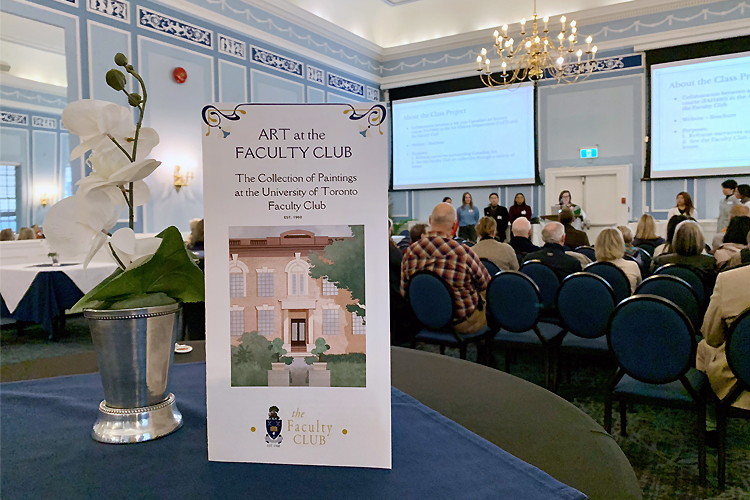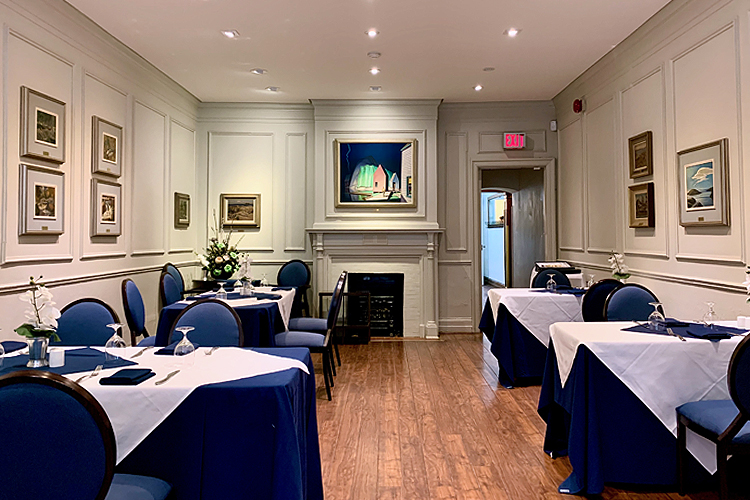A group of art history students are reframing the Faculty Club’s distinguished art collection and rethinking how stories are told about celebrated Canadian paintings.
Though not terribly well known, the Faculty Club houses an impressive collection of 20th-century Canadian paintings that includes works from the Group of Seven, David Milne, Doris McCarthy and more.
Adorning the walls are paintings and preliminary sketches that celebrate Canadian landscapes such as North Shore, Lake Superior by Lawren Harris, Algoma Hills by A.Y. Jackson, Glacier Bay by Doris McCarthy and Spring, Nova Scotia by Arthur Lismer.

Yet Faculty Club members who pass by these works on a regular basis often don’t know much about them. That’s why the Faculty Club approached Jessica Mace’s class to help highlight and contextualize the collection for its members and visitors.
“Many people consider Canadian painting somewhat stuffy and old-fashioned, so we worked on reframing the narratives,” says Mace, a postdoctoral fellow with the Department of Art History in the Faculty of Arts & Science.
As part of her fourth-year seminar, Framing Canadian Art, Mace’s students undertook a semester-long project, engaging directly with the collection to help generate renewed interest and attention into the impressive collection.

“Through this project, some students discovered that they actually enjoyed research,” says Mace.
“They dove in head-first and really took ownership. They immediately saw the potential of this under-researched, under-served collection and were excited to produce something that could help others learn about these little-known artworks.”
The class chose to focus on two frequently used public-facing rooms in the building that happen to have the greatest concentration of artists from the early- to mid-20th century, “and incidentally, some of the heavyweights of Canadian art history,” says Mace.

To prepare for this project, the class visited other art collections and sites around campus and the city and spoke to art-world professionals to better understand how different spaces present and narrate their Canadian art for a broader audience.
Mace’s class then divided into teams — one team helped create a new brochure for members and guests, outlining the Faculty Club’s history, a plan of the rooms showing where each piece is hung, as well as short biographies of some of the artists.
Another team helped create the website, Art at the Faculty Club, which provides a digital version of the brochure, as well as in-depth articles that explore the artists’ lives, their work and how these pieces came to arrive on the Faculty Club’s walls.
The website also includes architectural renderings of the building based on archival drawings, a floor plan locating each of the paintings, drawings of each of the rooms, and a full virtual 3D model of the rooms studied. There’s also an interactive map of Canada, identifying where the various works in the collection were originally painted to provide a land-based understanding of the works.

The students took the baton from Mace and ran with it, coming up with creative ways to explain and celebrate the artwork.
Sierra Bailey, a fifth-year art history student and a member of New College, helped compile a timeline of major events within the club’s history by dusting off its art archives. She also helped create the brochure.
“This research project helped me exercise skills in research and stay organized while compiling information from different sources and filling in gaps in research by connecting information together to create a broader picture,” says Bailey.
“It was a great representation of what we as students are capable of when given the opportunity to explore and expand on skills we feel we’re best at. Everyone had such an important role in this, and Professor Mace ensured no one was left behind and had something to contribute; so, it is really a true representation of our talents as a student body.”
Celina Lee, a fifth-year student double-majoring in art history and cinema studies, and minoring in digital humanities as a member of Innis College, was responsible for creating the website’s digital map.
She loved the project’s real-world connection, relishing the opportunity to collaborate with organizations outside the university.
“This was a great way to synthesize in-school learning with real-life by bringing together the theoretical and practical,” says Lee. “I was also able to add onto my existing research skills because of the challenging nature of my chosen topic. In addition to examining scholarly sources, I branched out to also collect informal sources of information such as blogs, travel sites and municipal projects.
“I’m most proud that we were able to create an entire project from start to finish within the 12 weeks of the winter semester. The whole class collaborated to create a project that allowed all of us to shine both individually as well as a group by leveraging our skills and interests. Despite the time constraint, we were able to create a fantastic project that does the Faculty Club proud.”
To highlight their work, the Faculty Club hosted a launch party on April 18, giving the students the chance to present their work and interact with club members directly.
“This wasn’t part of their grade at all,” says Mace of the students’ enthusiastic participation. “I was blown away, but it goes to show just how amazingly capable U of T students are, and that if we trust them and give them some freedom in their work, they will exceed expectations.
“I saw things click,” she adds. “I saw them understand that their academic skills are transferable to different contexts and understand how they might be applicable outside the classroom. I think it gave them confidence in their career potential going forward. It shows that there is a hunger for these kinds of experiential opportunities.”


